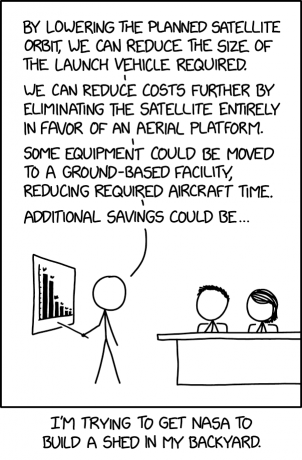Difference between revisions of "Main Page"
(fix count and add explanation) |
(404 can arguably be considered a comic (if unorthodox) plus it does have an explanation here. OTOH, another subcategory was added to Category:Comics, so the total is still 10.) |
||
| Line 5: | Line 5: | ||
<big>''Welcome to the '''explain xkcd''' wiki!'' | <big>''Welcome to the '''explain xkcd''' wiki!'' | ||
We already have [[:Category:Comics|'''{{#expr:{{PAGESINCAT:Comics}}-10}}''' comic explanations]]!</big> | We already have [[:Category:Comics|'''{{#expr:{{PAGESINCAT:Comics}}-10}}''' comic explanations]]!</big> | ||
| − | <!-- Note: the -10 in the calculation above is to discount subcategories (there are | + | <!-- Note: the -10 in the calculation above is to discount subcategories (there are 8 of them as of 2012-11-22), |
| − | non-comic pages (2 as of same date: [[List of all comics]] and [[Exoplanet]]) | + | and non-comic pages (2 as of same date: [[List of all comics]] and [[Exoplanet]]) --> |
| − | |||
(But there are still {{#expr:{{LATESTCOMIC}}-({{PAGESINCAT:Comics}}-10)}} to go. Come and [[List of all comics|add yours]]!) | (But there are still {{#expr:{{LATESTCOMIC}}-({{PAGESINCAT:Comics}}-10)}} to go. Come and [[List of all comics|add yours]]!) | ||
Revision as of 18:20, 22 November 2012
Welcome to the explain xkcd wiki! We already have 5 comic explanations!
(But there are still 3192 to go. Come and add yours!)
Latest comic
| Cost Savings |
 Title text: Unfortunately, my scheme to trick NASA has now taken over a decade longer than planned and has run way over budget. |
Explanation
This comic depicts a ridiculous scheme, concocted by Cueball, to dupe various representatives at NASA into doing a menial task for him; specifically, he wants them to build an ordinary shed in his yard. NASA, being the National Aeronautic and Space Administration, is not associated with hobbyist carpentry and certainly cannot be conventionally ordered to build a shed on a needy citizen's property. Thus, Cueball takes a sly approach, trying to mask his true intentions in a long-winded cost-cutting presentation about a proposed satellite launch. Initially, it appears he is suggesting various ways to improve the cost/hassle of launching a satellite into orbit, but soon the suggestions become less about making the satellite's construction and launch more efficient and more about constructing a random structure on the ground, each one getting closer and closer to "Ditch the satellite idea and build a shed in my yard."
The title text is a humorous reference to the many, many project delays and unforeseen expenses that arise during the process of sending a rocket into space. It implies that Cueball has been attempting this scheme for long enough that it mirrors the setbacks a team would experience if they were actually sending a satellite into orbit.
Transcript
- [Cueball is standing in front of a framed graph on a wall, pointing at it with a short stick. The graph is a bar graph with steadily decreasing bar heights. Hairy and Megan, seated, are looking on from behind a desk.]
- Cueball: By lowering the planned satellite orbit, we can reduce the size of the launch vehicle required.
- Cueball: We can reduce costs further by eliminating the satellite entirely in favor of an aerial platform.
- Cueball: Some equipment could be moved to a ground-based facility, reducing required aircraft time.
- Cueball: Additional savings could be...
- [Caption below the panel:]
- I'm trying to get NASA to build a shed in my backyard.
New here?
Feel free to sign up for an account and contribute to the explain xkcd wiki! We need explanations for comics, characters, themes, memes and everything in between. If it is referenced in an xkcd web comic, it should be here.
- If you're new to wikis like this, take a look at these help pages describing how to navigate the wiki, and how to edit pages.
- Discussion about various parts of the wiki is going on at Explain XKCD:Community portal. Share your 2¢!
- List of all comics contains a complete table of all xkcd comics so far and the corresponding explanations. The red links (like this) are missing explanations. Feel free to help out by creating them!
Rules
Don't be a jerk. There are a lot of comics that don't have set in stone explanations, feel free to put multiple interpretations in the wiki page for each comic.
If you want to talk about a specific comic, use its discussion page.
Please only submit material directly related to—and helping everyone better understand—xkcd... and of course only submit material that can legally be posted (and freely edited.) Off-topic or other inappropriate content is subject to removal or modification at admin discretion, and users posting such are at risk of being blocked.
If you need assistance from an admin, feel free to leave a message on their personal discussion page. The list of admins is here.
Logo
Explain xkcd logo courtesy of User:Alek2407.
